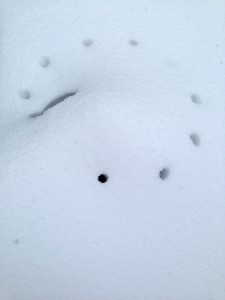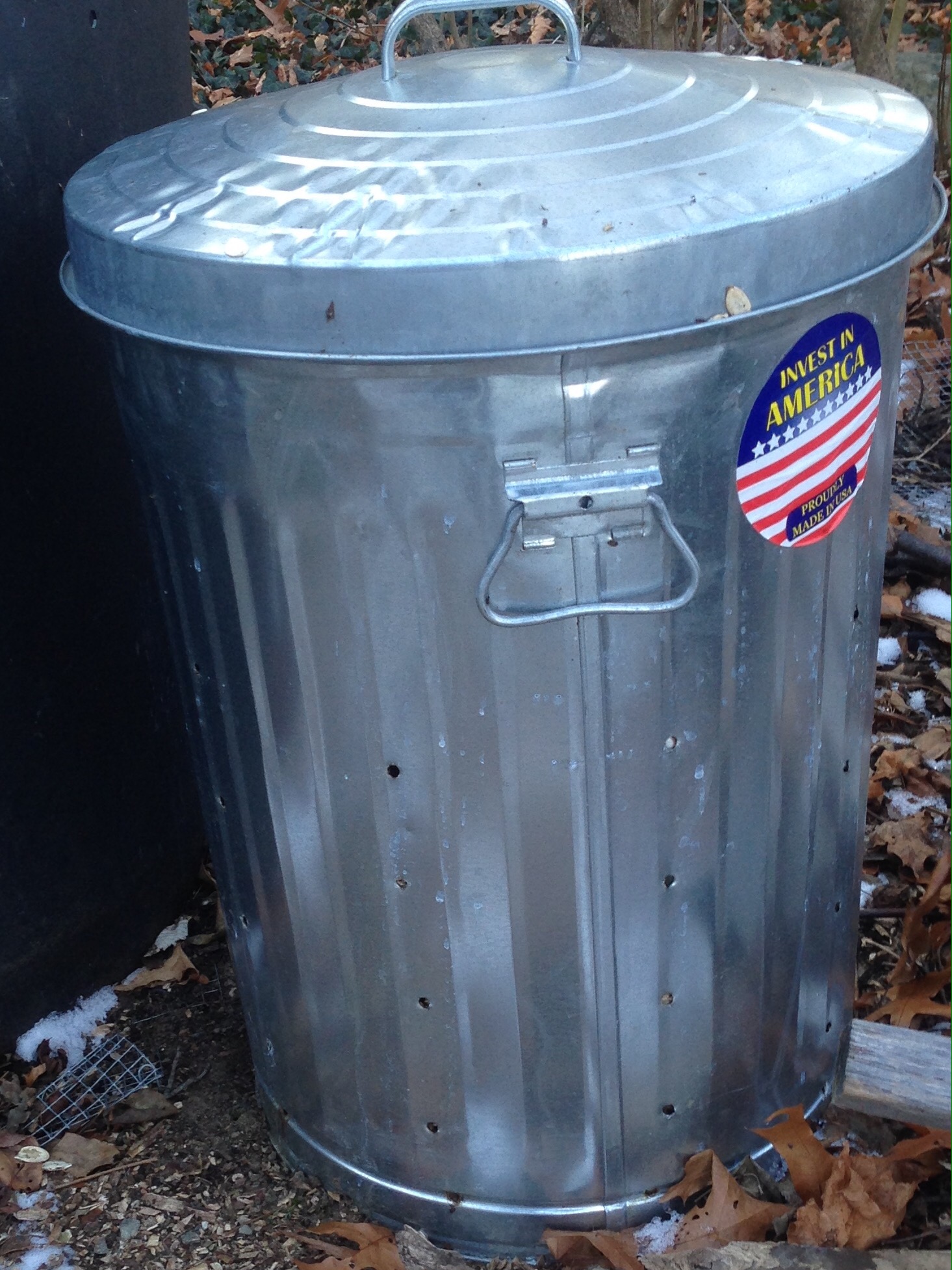
Thermometer is frosty, but inside the bin it is a cozy 140 F.
There are two important things to know about winter composting in places like Massachusetts:
1. Winter composting is possible and requires little more than frequent additions.
2. If your compost freezes over, which is normal, that is NOT A PROBLEM! The pile will restart once the weather warms.
I am generally able to keep my compost cooking throughout the winter, but please understand that is not typical and not necessary. We do a lot of cooking – all vegetarian, and thanks to year-round allergies, we’re adding lots of tissues (which quickly decompose) as well. Material is added almost daily, and I include a few big bags of used coffee grounds (high in nitrogen) during the process.
All that is to say that our composting habits are not typical, so please don’t use our compost success as a measure for yours.
Still, I love showing people photos when they tell me it isn’t possible to winter compost in Massachusetts.
I’m going to address two basic items here:
1. How to keep composting throughout winter.
2. What to do if you run out of space in the compost.
How to keep composting throughout winter

Recognize the hole pattern? They match the holes on top of the compost unit – hot air escaping the unit melted these holes. (See the video above.)
Keeping your compost cooking all winter is as simple as this: Keep adding material frequently, preferably daily, in the correct proportion, but erring on the side of too much nitrogen. That means that for every container of food scraps, add two containers of carbon rich material (leaves, newspaper, used tissue, etc.). That is the same advice for summer compost, though in warmer weather you can be slower about adding it.
Both frequent additions and correct proportions are important for a hot winter compost. Summer compost is more forgiving.
If you:
1. Add lots of nitrogen-rich material,
2. Neglect to add enough carbon-rich material,
3. It freezes, then ->
in the spring it will look like a slimy pile of sludge and smell like an open sewer. So maintain that nitrogen:carbon ratio and you’ll be fine, whether it composts in the winter or not.
Remember that your used tissues are a great compostable carbon-rich source that breaks down quickly, and there’s always newspapers as well, if you run out of leaves.
Smaller pieces decompose faster, aiding compost fauna. However, do NOT go buying

Chopping broccoli speeds decomposition, with apologies to Dana Carvey.
machines to chop your food, push your leftovers through a meat grinder or put your leftovers in the Vitamix. Whacking the stalk into five or six pieces rather than tossing it in whole is helpful and plenty sufficient. It is also fine if you don’t chop it at all.
As always, adding nitrogen-rich used coffee grounds, available free at most coffee shops, will help your compost heat up quite nicely.
You should also, of course, try to turn the pile every once in a while so the bacteria get air, even if you’re just plunging a rod in into the pile to make some air available. You may find it easier to use a large bulb auger in a cordless drill, rather than a pitchfork. (I make no money off of sales: I highly recommend using an auger.)
Remember, if it still freezes, no problem. As long as you’ve been adding material in the correct proportion (1 part food scraps, 2-3 parts carbon-rich material), the pile will heat up nicely once the weather warms and it will cook rapidly. If it does stink in the spring (very common), just be sure to mix the material frequently and, as necessary, add carbon-rich material – the smell will go away quickly.
What to do if you run out of space in the compost

Help! My compost can’t eat another bite!
Despite best efforts, your compost froze. Not a problem.
The bin is now full, with an appropriate mix of food scraps and carbon-rich material. No problem.
You’ve got another three months of winter and nowhere to put your food scraps. Now you’ve got a problem.
So how do we fix this? First of all, let’s have a learning moment.
You now know how to compost all winter. Do that next year and, as the material decomposes, piles shrink 1/3 to 1/2 in size, allowing you more space for new material. The second thing to learn is that maybe you should have a second compost unit. In Arlington and surrounding towns, inexpensive but high quality compost units are available daily from DPW.
It’s too late for that though, so what do you do now? Here are some options:
1. Find a friend who composts and still has space. They may return the favor some day.

Inexpensive metal trash cans make great, critter-proof winter “storage” bins, or can be used year-round. (Larger is better for year-round use.)
2. Freeze your food, outside. Its freezing outside, so put your food scraps there. To keep the critters out, you can buy an inexpensive metal garbage can and a bungee cord. Bang a few air holes with a hammer and nail (or use a drill and metal bit) and you’re done.
Or you can buy 5 gallon buckets with lids or get them for free from your favorite local restaurant. (For convenience and money, the metal can will do you much better.)
It is wise to put some of carbon-rich material in the bottom of the can/bucket before adding the food. Leaves, newspaper or another carbon source will help prevent odor problems, should the contents begin to decompose before you have a chance to empty it.
Put your food scraps in there and seal it shut. Keep adding until it is full or heavy enough that you need to empty it.
I haven’t tried it yet, but Leaktite (and perhaps others) makes a lid and adapter (under $10) that turns your bucket top into a screw-top lid, which (in theory) should be easy for humans, and more difficult for animals, to use than the standard snap-tight lid. I still think a metal trash can is a better option.
WHEN YOU ADD THIS SAVED FOOD MATERIAL to your compost, make sure you add 2x-3x as much carbon-rich material, if you haven’t already.
3. Start a worm compost bin. Lots of people do it, and there are lots of good reasons to vermicompost, including that you won’t need to put snowshoes on in order to reach your compost bin in sub-zero temperatures. You’re not likely to run out of space, either.
Massachusetts DEP recommends vermicomposting, with a robust website. I generally don’t address vermicomposting because it is a very different setup than typical outdoor composting, but it isn’t difficult, and those who do it rave about both the fun and the quality of the compost it produces. If you think you’ll run out of space or want the convenience of composting indoors, give it a try.

